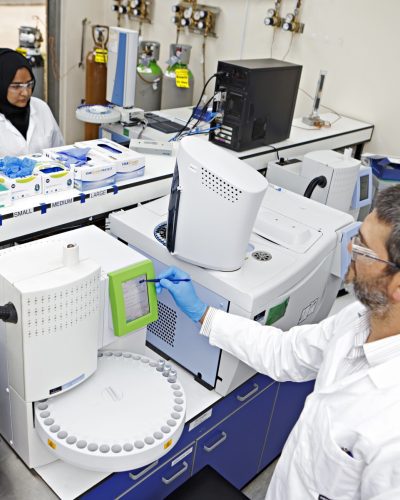Extractables and leachables
Packaging, storage and distribution of products are important parameters to investigate when seeking to understand the quality of your product and its potential to introduce unwanted substances to the human body. We can offer a comprehensive suite of testing to support your assessment of biocompatibility, encompassing drug products, medical devices, advanced wound management, and a wide range of proprietary products.
Biocompatibility studies
Biocompatibility testing includes extractables and leachables (E&L) phases which investigate substances (organic and inorganic) that could potentially be released to a patient or user from medical devices, pharmaceutical production and pharmaceutical packaging, amongst other areas.
Extractables are defined as contaminants that can be extracted from plastic (and other materials) under exaggerated conditions such as using a volatile non-polar solvent at accelerated temperatures for 72 hours for example.
Leachables are those substances that are likely to be present in the product due to its close contact with a production system (and storage), container, and delivery system, and which might be leached out during normal usage.
The aim of an E&L study is to identify and quantify chemical species to allow an informed toxicological risk assessment and to support a biological evaluation, including Analytical Evaluation Threshold (AET).
Regulations and study design
There are several guidelines that can be used for studies. The choice of guidelines will depend on the type of product and on the requirements of the regulatory bodies to which the biocompatibility data is going to be submitted.
ICH, USP <1663> /<1664> and ISO 10993 provide guidance on testing for extractables and leachable analysis, but one of the most important aspects to consider is that the extraction of the sample simulates the storage and end use of the product.
ISO 10993-18: Biological evaluation of medical devices — Part 18: Chemical characterization of materials, is the key reference standard for assessing the biocompatibility of the chemical nature of medical devices. This standard provides a risk assessment framework, as well as guidance on the appropriate workflow for the specific device or product.
Cormica and our group laboratories have extensive experience in performing E&L studies and have tested a wide variety of products using the techniques listed in the table below. An accumulation of all of these techniques is required to get a full picture of the behavior of samples, when subjected to varying extraction conditions.
More Analytical Chemistry:
Analytical Chemistry Resources
Extractables and Leachables Study design
Cormica have extensive experience in performing E&L studies and have tested a wide variety of products using the techniques listed in the table below. An accumulation of data from these techniques is required to get a full picture of the behavior of samples, when subjected to varying extraction conditions.
Typically, analysis for organic compounds of difference between the product extractions (polar and non-polar media, relevant extraction times and temperatures) and the blank extraction media are undertaken, using typically focussing LC-UV/MS (for non-volatile compounds) and GC-MS (for volatile and semi-volatile compounds).
Depending of the nature of the product, elemental analysis, total organic carbon and ion chromatography can also be included. Board-based screening methods are adopted, followed by quantitative analysis using certified reference standards, where appropriate / required.
| Technique | ‘Unknown’ Analytes | |||
|---|---|---|---|---|
| Volatile / Semi-volatile Organic Compounds (VOC / SVOC) | Non-volatile Organic Compounds (NVOC) | Anions & Cations | Elemental Extractables | |
| ICP-OES/MS† | ✔ | |||
| LC-UV/MS* | ✔ | |||
| LC-CAD / ELSD | ✔ | |||
| Ion Chromatography | ✔ | ✔ | ||
| GC-MS* ¥ | ✔ | |||
| Total Organic Carbon | ✔ | ✔ | ||
*followed by MS/MS, where required
†compliant with USP<232> /<233>
¥Headspace and Direct (Liquid) Injection
Extractables and Leachables Capabilities
- GMP and GLP accredited; FDA inspected
- Method development, establishment, verification, and validation to GMP and GLP
- Method transfer to and from customer laboratories, Third party transfers
- Quantitative methods / Limit tests / Qualitative methods
Wide range of analytical techniques
- HPLC / uHPLC
- UV, PDA, Fluorescence
- ELS, RI, CAD, MS, MS/MS
- Gas Chromatography
- Liquid, Headspace, Solid-phase microextraction
- FID, MS, MS/MS
- Ion Chromatography (anions, cations, sugars)
- ICP-OES and ICP-MS
- FT/IR
- SEC/GPC
- TOC




